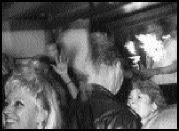PICTURE IT: Pioneer Square alleys free of vermin, garbage, and the overwhelming smell of urine, where tourists and locals can mingle and settle in for drinks or afternoon coffee at a sunlit alleyside cafe. Such pedestrian- (and car-) friendly alleys are part of the long-term vision of cleanup crusaders like Chris Martin, who want to rid the alleys around the Square of their stench and filth. Martin’s company, CleanScapes, has launched an effort to clean up the corridors by replacing the Dumpsters in three of the area’s 15 alleys with individual, reinforced plastic bags.
But whether you see Martin’s effort as one more yuppie affront to Seattle’s Skid Road or a reasonable neighborhood improvement plan, you’ll have to agree that it has had an unintended consequence: the Dumpsters’ most ubiquitous denizens—rats—suddenly have no place to hide.
Those four-legged vermin, for years a common site in many a Pioneer Square basement and alleyway, flock to Dumpsters because they’re both soup kitchen and shelter, providing an ample food source and a warm place to hide. (Martin claims the plastic bags prevent the rats from smelling the food inside.) Health department regulations require, in theory, that Dumpsters be locked and tightly chained; but a short walk through a few Pioneer Square alleys confirms that, at most, three in four Dumpsters in the area are properly secured. Rust and corrosion also conspire to create passageways for hungry rodents.
But take the Dumpsters away, some Pioneer Square property owners and tenants say, and the rodents come into the buildings. Rosemary Rice of Pioneer Square Properties, which manages the Globe Building at the corner of First and Main (where Elliott Bay Book Company is located), says she’s noticed an increase in the rat population since the alley behind the store was cleared. She blames nearby construction—much of the south part of Pioneer Square has been torn up to make way for a new sewer line—and the removal of the rodents’ food source for the sudden proliferation. An employee at the Tully’s on First and Yesler says that when he took out the trash one recent night, a rat scurried out of the alley and into a hole in the side of the building. And Tina Bueche, owner of the Diner restaurant on South Washington, says she’s heard increased reports of rats from business owners in nearby buildings. “A number of people have commented that the rat population has become more aggressive or more visible,” Bueche says.
Hilary Karasz-Dominguez, a spokesperson for the King County health department, confirms that removing rats’ food source usually forces them to find another nesting place. “Rats are clever, and they will look for other food sources and other places to sleep,” she says. “You have to make sure that simultaneously you get rid of other food sources, or they may just move.”
Some residents say the trade-off may be worth it. Rice notes that the alleys were “kind of intimidating” before, and many are still far from pleasant. “These alleys get used for bathrooms, and during the summer it just smells really bad—there’s a lot of drug dealing going on and people hiding behind the Dumpsters.” CleanScapes’ Martin says removing the Dumpsters has had a dramatic effect on the appearance and perceived safety of the alleys. And at midafternoon on a weekday, anyway, it seems he’s right; pedestrians stroll down the middle of the suddenly wide-open alleys, and the smell of urine is palpably absent.
But others, including some who support the program like Underground Tour manager Steve Crosier, say better policing and improved cleanup efforts have made a greater long-term difference than the Dumpster removal. “Fifteen years ago, it wouldn’t have been uncommon to find people shooting up and piles of human poop everywhere. That’s really changed,” Crosier says.







